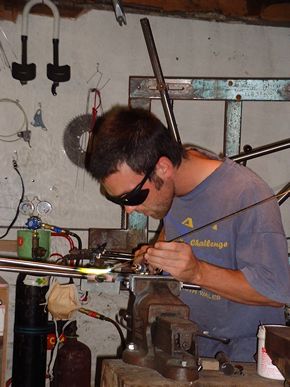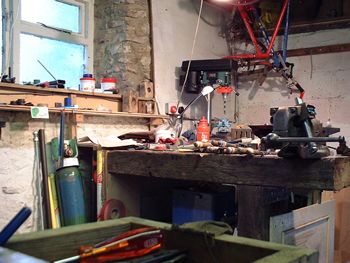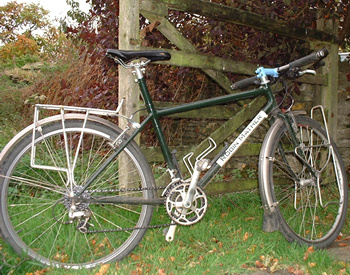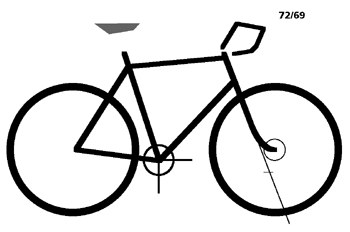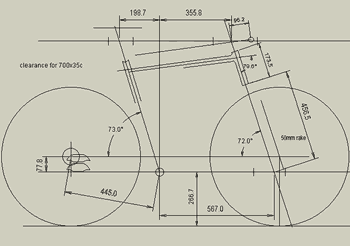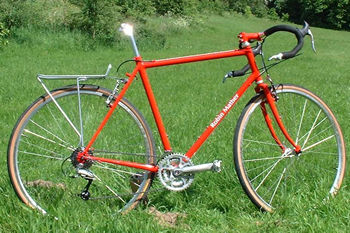[ 63XC.COM | STORIES | ROBIN MATHER ]
Meet Your Maker
Offroad fixing is an up-and-coming idea, so it seemed like a good idea to talk to an up-and-coming maker. Robin Mather is establishing a small bikebuilding operation in Bath, a hilly inland town in the southwest of England. We chatted about the lengthy process of becoming a framebuilder, and about the design of an offroad fix.
63xc.com: How did Robin Mather Cycles get started? RM: Well, I like making stuff and I like cycling and the two things naturally went together. I knew pretty early on that I wanted to build bikes. My teachers at school weren't much help. But one day I saw a guy riding a recumbent, and I stopped him. It turned out that he had built the bike himself. He was a teacher, but at a different school. He taught me how to fire up a torch, heat the metal, all the basics... 63xc.com: I couldn't help noticing the extraordinary quality of the fillet brazing on your head tube. Not something you could learn quickly, I think. RM: I think you can be adequate quite quickly. You can make a sound joint with a ten-minute lesson and a couple of hours' practice. But I'm still getting better, after ten years of doing it. I worked for Dave Yates for a little bit and picked up stacks of stuff but I was already building frames before I did that. 63xc.com: Dave is the guy who does the randonneur bikes, isn't he? I know some of his compact designs with sloping top tubes. RM: Dave does a little bit of everything. Most of his business is in road racers, light tourers, audax stuff, mostly lugged. He was well-known amongst early mountain bikers, though while I was there he made very few--there's just not much of a market for custom MTBs anymore. The whole thing has gone towards mass production. 63xc.com: You were born and brought up in Bath. How is it working here? RM: Good. I've got a workshop at my folks place, where they've lived for 25 years. It's a small space, but the overheads are low, I get to see my grandparents every day...
63xc.com: What do you have in the way of kit? RM: Well, there's a framebuilding jig that Dave Yates made for himself and sold on to me when I left. There's a bench I made out of an old railway sleeper. The usual tools: files, hacksaws, drillpress. That's about it. 63xc.com: I guess most aspiring framebulders would want a good jig? RM: I have made frames with bits of string and a long ruler, but it's a fiddle. 63xc.com: Is that the pin-and-braze thing? RM: Nope, that's only good if you've got lugs. Plus you need some kind of jig to get the pins in the right place! It's no use at all for fillet brazing. 63xc.com: Oops. Um, well, so, what kinds of bikes do you use this skilful brazing on? RM: Well, I'm still into recumbents, maybe because that was my very first experience... 63xc.com: Unusual. RM: ...but my main interest has shifted to uprights. I've been able to make quite a number--a few mountain bikes, a lot of light tourers and audax machines. It's the Dave Yates niche again, those seem to be the types not catered for by the big manufacturers. Plus I evolved my own personal machine, a strong 26" flat-bar tourer, and built a number of similar ones for other people. 63xc.com: Your personal bike is a long way from being a classic tourer. It's more like a mountain bike. RM: I think that's because, when I bought my first bike, the generic bike was a mountain bike with a sloping top tube. I wasn't initially aware of the classic lugged touring bike. My first tour was on a Kona, which was comfy, strong, stable, did everything a touring bike should do... When I built myself a touring bike, it was like a mountain bike, but with touring geometry. Robin's personal bike 63xc.com: Who were the influences on the geometry? Where did you get the ideas from? RM: Tony Oliver. 'Touring Bikes, A Practical Guide.' It's an anorak's dream. It's a nice proper published book, with lots of answers in--much better than scratching around finding clues where you can. Also I analysed very carefully the strong points and faults of my Kona and those of a number of other bikes I had built over the years. My shed is full of frames I built myself and then used for a bit before moving on. 63xc.com: I imagine it's very hard to get started in framebuilding without going through a phase of crazed experimentalism. RM: I'm not sure, really. The first bike I built was almost a complete ripoff of my Kona. Standard mountain bike geometry, clearances, tubeset... Then I built a recumbent trike, which looked novel, but was really just a clone of the WindCheetah. Then I started experimenting more boldly. I was dragging bikes off the tip, chopping them up and rebrazing, just to practice. There is a difference between the engineering design of a bike and the manual skill of making it. Experimenting with design will tend to lead you down dead ends that have been explored before. My experimentation was mostly to do with the process of making a frame, how to cut and jig joints, what order to do things in, how to keep it straight... 63xc.com: I'm interested in your variety of experience, because it means you're capable of approaching a project with an open mind. Apart from the excellent Matt Chester, no-one out there has a production offroad fix. I'd like to treat the rest of the interview as if I was a customer. We can begin to thrash out an offroad fix design. Perhaps 63xc.com readers can learn from the process and use it to help them approach their own framebuilders. RM: Fine with me. 63xc.com: How do you normally begin the discussion? RM: Well, there's a few simple questions. What sort of cycling do you want to do? What do you ride at the moment? Why do you think what you have now isn't right? 63xc.com: Well, in answer to your first question, I live mostly in Hampshire, on the downs. A typical ride begins with a steep climb onto the hills. But then there'll be a fast ride across rough but open ground, a flint track, with big stones but not too many worries about mud and treeroots and so on. RM: What about the bike? 63xc.com: My ride is a 1950s Hopper which by accident has turned out to be a wonderful offroad fix. The makers made the frame out of 8lb of cheap plaingauge 531, making it extremely strong and quite responsive in ways that work well offroad. 700c wheels, of course. I think 26" wheels work fine in gearie contexts, but you really need big wheels on a fix. And it has a 120mm rear hub spacing. On a fixie, you may as well keep the Q factor low. RM: No trouble finding hubs at that spacing? 63xc.com: Nope. BBs are easy enough, too. RM: So what are the problems? 63xc.com: The most glaring one is the straight toptube, which is going to do me serious damage sometime. Then there's the front end. The Hopper is from that period of cycle design when the rider would carry most of their weight on the rear wheel, the era of 32/40 spoking. The top tube is very long and the front wheel often feels underloaded, which is not great for the occasional bit of technical stuff, or for hill starts. Also, clearances are very tight, so mud tends to pile up within the frame angles, especially between the frame and chainwheel.
I did a basic plan for an improved version. It's not CAD, but it's good enough to show you what I'm on about. I tried to keep the bars and saddle and BB in roughly the same positions but I sloped the top tube. I built in a very slack head tube angle of 69°--that's to try and provide decent shock absorption on the front without using a suspension fork. Those flints are murder on the wrists! I've also put in a 72° seat tube because I find it a strain to stand up on the Hopper... RM: Have you been able to measure the seat tube angle on the Hopper? 63xc.com: I think it's in the high 60s. Very old, almost prewar design. My town bike is a 74° parallel Carlton and I can get straight up and push that with no trouble at all. RM: I would probably go with a 73° seat angle, because it goes with everything. If you were riding a geared road bike, I might advise a slacker seat angle. But given what you say about keeping weight on the front wheel and climbing out of the saddle, I reckon 73° would be a good place to start. Sloping the top tube is no problem, but it will rule out the use of lugs--you'll have to go for fillet brazed or TiG welded, at least on the top three joints. 63xc.com: I'm amazed that no-one has done lugs for sloping tubes. RM: I think Henry James has some, but they're pretty specialist and I'm not sure I can place a small order from this country. 63xc.com: Well, if the fillet brazing is as nice as on your bike, I'd be happy to go down that route. What about the front end? I just pulled the head tube back and stretched the stem to keep the handlebars in the same position. RM: Let's see. You tried to maintain the relationship between saddle, bars and BB? You can't quite do it, because the BB will be further back relative to the seat because of the steeper seat tube. But, shorter top tube, longer stem, that would improve the weight distribution. I would also steepen the head angle slightly, maybe to 70° or more, and reduce the rake a bit. That should sort out the low-speed handling. 63xc.com: What about the forks? I copied them from an old EG Bates I saw at Ripley. RM: Well, they're better than the dead straight ones, anyway. 63xc.com: Those ones always looked crazy to me. Where did they come from? RM: I dunno. I remember watching the Tour one year when they were quite new. The camera bike was following the pack down a mountain, hairpins, the whole lot. A bunch of 12 riders came up to this fast corner. Most of the group went round, but three of them went straight off. And they were all from the same team. And the voiceover goes, "That's interesting, that's the team that uses straight forks." 63xc.com: Arg! RM: But straight ones have this kind of aggressive look that some people go for. I think with roadbikes, people get muddled between responsiveness and speed, and they put up with a harsh uncomfortable ride because they think it makes them faster. Time trials bikes are often built with very upright head angles, and the twitchiness gives you a sense of speed. But in fact a bike with more stable steering is probably faster in most practical applications, because you can ride a straight line with no effort. 63xc.com: Is there a perfect head angle? RM: I don't think any one angle is ideal for every application. Bicycles are so highly evolved that anything within the normal range of 69° to 74° will work. But I just read Mike Burrows' book, where he made a LWB recumbent with an adjustable head angle. He said he only noticed handling differences at increments of 10°. Also Tony Foale did some interesting experiments on motorbikes. He found that normal geometry did not always give the best handling. Instead, it had evolved to give a compromise between handling, weight distribution, mechanical simplicity and the packaging of major components. 63xc.com: That's interesting. RM: I don't think it translates too directly to an upright, but I still don't think you should get too hung up on minute changes in frame geometry. So many things affect the way a bike handles... One of the major ones is tyres. Tyres and the pressure at which you run them make a huge difference. 63xc.com: One of my own hobbyhorses is that I think people use too narrow tyres. I got into 1 1/2" tyres for offroad stuff and I can't really say that my road performance has been affected, except that I can attack potholes. Plus I think fat tyres and thin tubes look really good together. RM: I think you should make the chainstays long. That'd help with the mud clearance and weight distribution. 63xc.com: I think I chose the Rivendell length. I wanted a big gap between the seat tube and the tyre. RM: Probably pretty long, then. I can't remember what they use. 63xc.com: And a low BB, about a 6cm drop, which I like for stability, I don't have great balance. RM: That surprises me slightly, for an offroad fixed gear. I'd have thought you wanted a high BB. 63xc.com: What drop would you go for? RM: Well, I prefer to talk about BB height from the ground--11", maybe? 63xc.com: That's higher than I'm used to. Is that because of the risk of grounding a pedal in a corner, or what happens when you're going over tree roots? RM: On an offroad bike, the latter, I think. That's especially true for you, since you can't freewheel over obstacles with the cranks horizontal! In my touring bikes it's just because I like it. It makes it easier to achieve a compact frame, and I see no reason to change it. I did once make a touring frame with a low BB, and it was 'orrible. It felt really sluggish, particularly out of the saddle. It felt like its back was broken, somehow. I like to stand up, and get over the bars. 63xc.com: You're pretty sympatico with fixers, then. Would the short cranks make a difference? I'm on 165mm. Most fixers like short cranks... they're easy to spin if you're moving very fast. RM: Singlespeeders reckon long cranks are the way to go because you get better leverage... 63xc.com: It's a bicycle culture thing, isn't it? SSers like long cranks, and I guess that it's to do with low speeds, steep climbs, and mud. Fixers on or offroad tend to enjoy travelling fast over flatter territory... RM: Well, I'm on 170s, so there's not a huge amount of difference. Those dropbars, on the other hand... 63xc.com: I'm going off drops. I've had several experiences of grabbing for the brake lever at speed in bumpy conditions and missing. So I'm moving either to bullhorns or trial bars. RM: What's a trial bar? 63xc.com: It's a spin on the old North Road idea, flared bars downsloping below the top of the stem. The idea is to have the main riding position be the one with the brake accessible and the subsidiary be the one without. At the moment I have them the other way round, which is a bit crazy. RM: Where do you put your hands at the moment? 63xc.com: On the flats, mostly. I like to look around, and I have some back problems. I don't like my hands lower than the saddle. Drops are for headwinds and sprinting in traffic. RM: I notice you've got a tall, short-reach stem. If we're sloping the top tube you may not need it. 63xc.com: What do you think about that yourself? RM: There are some advantages to having a longer headtube. But the aesthetics are tricky: if you slope the top tube too much, it starts to look like a ladies bike. 63xc.com: A bigger slope would enable me to get the bars up with any old stem. My own design would almost certainly require a custom stem. RM: It's tricky to build a big frame with a sloping top tube and not have it end up looking too short or too tall. It departs from the norm. 63xc.com: This is a problem. Cycle aesthetics develop in response to the machines that are around, of course. If you had turned up in 1960 riding a dual-suspension MTB, people would have said "What is that ugly beast? It's hideous! The tubes are too big, and the wheels look like they came off a motorbike!" For most fixers, aesthetics means a Cinelli road frame with very thin tyres. No-one knows what an offroad fix looks like. Matt Chester I think has done a very good job of carving out a new aesthetic with the Indie Rock, but he's on his own. RM: Does Matt say much about frame geometry? 63xc.com: Well, the Indie Rock is offered fully custom, so in theory it's built how you like. But as far as I can tell, Matt like short rear triangles, quite upright angles... Plus he goes for a particular fork, the Kinesis, which has a very short rake. Back to our bike: do we need butted tubing? I think that climbing out of the saddle might make a difference. RM: Butted still makes sense: there's no need to carry around extra metal where you don't need it. A larger diameter downtube would add some stiffness. Maybe beef up the chainstays a little. 63xc.com: What about tapering them? RM: Most chainstays come tapered anyway. 63xc.com: Ah... RM: But you could choose the diameter: ovalised ones increase the vertical stiffness, and might help with the climbing. Stiffness is also an argument against long chainstays, by the way. 63xc.com: But we can compromise. RM: Sure. What about brazeons? 63xc.com: Pretty minimal. I'm keen on track ends rather than dropouts. RM: No problem. But you're not asking for a dedicated racer. You're after a bike that's strong and stable and fairly bombproof, so it might make a great tourer. I'd like to put on rack mounts and mudguard eyes. 63xc.com: I'm seriously interested in a hub brake mount. I got one of those Sturmey VT hubs cheap, and I'd like to have a mount for the reaction arm. RM: No problem. 63xc.com: Any thoughts about tubing? How would you approach it? RM: Well... round... I hate oval tubes. I think you're right about getting something pretty solid, so there's no point going for an 853-type steel: 525 or 725 would be fine. 63xc.com: Nice to work with? RM: Lovely. Lots of diameters and gauges. 853 is very recognisable to the consumer. A lot of people want it 'cos they've heard it's the best. But if you're getting pretty beefy tubing, there's no point in splashing out on special hardening processes. 63xc.com: I've barely progressed beyond 531--in fact, I still think Accles and Pollock would be pretty cool--so I'm not worried about the 853. RM: My bike is all 525, because I knew I would be putting a lot of luggage on it and there wasn't any point shaving a half pound. 63xc.com: What would be your target weight for this frame? RM: I don't really see why it has to weigh more than five or six pounds. 63xc.com: Built up gearless, that's a sub-20lb bike, even with big strong wheels. RM: I don't normally keep too much of an eye on the weight, I just use the tube that seems appropriate. A road frame will usually work out at around 4lbs. 63xc.com: I'm about 185lb and I used to squat 400lb, so I'm pretty keen on heavy-duty tubing, especially in the seat tube. RM: Well, we'll make it heavier if you want. 63xc.com: You don't get many clients saying that? RM: Not many. But a lot of clients aren't too bothered about weight. The basic idea is, 'whatever it takes'. 63xc.com: How much would you reckon for the complete frame? RM: Um, I'd have to consult my pricelist to be sure... but if I said about £600 or £650, that wouldn't be far off. 63xc.com: That's very good. There are off-the-peg numbers from Cannondale and Trek which would work out more than that for the frame, and they wouldn't spend hours talking to you about the design. RM: A lot of stuff is overpriced. Not just the production stuff, but some of the smaller cult custom makers. I think £1000 for a production steel frame, even small-run, is a ripoff. 63xc.com: Certainly the Rivendell thing, where you spend £2500 on your bicycle and it's yours for life, is wrong. It just doesn't work like that. Frames get broken. To trash a £500 frame that you like is a miserable experience, but it won't leave you suicidal. RM: Yeah. Durability in normal use and accidental damage are different things, though. 63xc.com: Well, I think that covers pretty much everything I wanted to talk to you about. How was it for you? RM: I think this was about right for a first meeting. If we were doing this for real, I would take all the measurements to feed into the computer, do some drafting, get a first-version plan of the frame ready in a couple of days. Then we'd use follow-up meetings to talk through the options and to resolve issues like standover height and head tube length. 63xc.com: Do you measure from the body, or do you work with the existing bike? RM: It depends how happy you are with what you've got. If you hadn't ridden for 15 years we'd have one kind of conversation. In your situation, where you've got a bike you're pretty happy with and you know what you want, it would be another. I'll send you a rough draft based on our discussion. Also, as it happens, I did a 700c tourer with a sloping top tube and lowish BB a few months back. I'll send you a picture. I think it's pretty close to what you had in mind. 63xc.com: Thanks, Robin. Let's stay in touch. The first draft One he prepared earlier
[ TOP ] |
Writer
Will Meister
Date
Version 1 October 2002
Related
Robin has his own site.
Tony Oliver's book is on Amazon.
Mailing list
Join the 63xc.com list.
